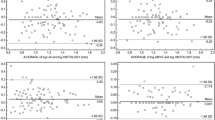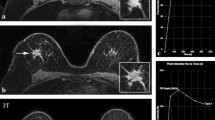Abstract
The aim of this study was to investigate the efficacy of a dedicated software tool for automated and semiautomated volume measurement in contrast-enhanced (CE) magnetic resonance mammography (MRM). Ninety-six breast lesions with histopathological workup (27 benign, 69 malignant) were re-evaluated by different volume measurement techniques. Volumes of all lesions were extracted automatically (AVM) and semiautomatically (SAVM) from CE 3D MRM and compared with manual 3D contour segmentation (manual volume measurement, MVM, reference measurement technique) and volume estimates based on maximum diameter measurement (MDM). Compared with MVM as reference method MDM, AVM and SAVM underestimated lesion volumes by 63.8%, 30.9% and 21.5%, respectively, with significantly different accuracy for benign (102.4%, 18.4% and 11.4%) and malignant (54.9%, 33.0% and 23.1%) lesions (p < 0.05). Inter- and intraobserver reproducibility was best for AVM (mean difference ± 2SD, 1.0 ± 9.7% and 1.8 ± 12.1%) followed by SAVM (4.3 ± 25.7% and 4.3 ± 7.9%), MVM (2.3 ± 38.2% and 8.6 ± 31.8%) and MDM (33.9 ± 128.4% and 9.3 ± 55.9%). SAVM is more accurate for volume assessment of breast lesions than MDM and AVM. Volume measurement is less accurate for malignant than benign lesions.







Similar content being viewed by others
References
Belli P, Costantini M, Malaspina C, Magistrelli A, Latorre G, Bonomo L (2006) MRI accuracy in residual disease evaluation in breast cancer patients treated with neoadjuvant chemotherapy. Clin Radiol 61:946–953
Partridge SC, Gibbs JE, Lu Y, Esserman LJ, Sudilovsky D, Hylton NM (2002) Accuracy of MR Imaging for revealing residual breast cancer in patients who have undergone neodadjuvant chemotherapy. AJR 179(11):1193–1199
Akazawa K, Tamaki Y, Taguchi T et al (2006) Preoperative evaluation of residual tumour extent by three-dimensional magnetic resonance imaing in breast cancer patients treated with neoadjuvant chemotherapy. Breast J 12(2):130–137
Partridge SC, Gibbs JE, Lu Y, Esserman LJ, Tripathy D, Wolverton DC, Rugo HS, Hwang ES, Ewing CA, Hylton NM (2005) MRI measurements of breast tumour volume predict response to neoadjuvant chemotherapy and recurrent free survival. AJR 184:1774–1781
James K, Eisenhauer E, Christian M et al (1999) Measuring response in solid tumours: unidimensional versus bidimensional measurement. J Natl Cancer Inst 91(6):523–528
Kaste SC, Liu T, Billups CA, Daw NC, Pratt CB, Meyer WH (2004) Tumour size as a predictor of outcome in pediatric non-metastatic osteosarcoma of the extremity. Pediatr Blood Cancer 43(7):723–728
Soutter WB, Hanoch J, D’Arcy T, Dina R, McIndoe GA, DeSouza NM (2004) Pretreatment tumour volume measurement on high-resolution magnetic resonance imaging as a predictor of survival in cervical cancer. BJOG 111(7):741–747
Kuhnigk JM, Dicken V, Bornemann L et al (2006) Morphological segmentation and partial volume analysis for volumetry of solid pulmonary lesions in thoracic CT scans. IEEE Trans Med Imaging 25(4):417–434
Bland MJ, Altman DG (1999) Measuring agreement in method comparison studies. Stat Methods Med Res 8(2):135–160
Therasse P, Arbruck SG, Eisenhauer EA et al (2000) New guidelines to evaluate the response to treatment in solid tumours: European Organization for Research and Treatment of Cancer, National Cancer Institute of the United States, National Cancer Institute of Canada. J Natl Cancer Inst 92(3):205–216
Miller AB, Hoogstraten B, Staquet M, Winkler A (1981) Reporting results of cancer treatment. Cancer 47(1):207–214
Okada K, Comaniciu D, Krishnan A (2005) Robust anisotropic Gaussian fitting for volumetric characterization of pulmonary nodules in multislice CT. IEEE Trans Med Imaging 24(3):409–423
Rubin GD, Lyo JK, Paik DS et al (2005) Pulmonary nodules on multi-detector row CT scans: performance comparison of radiologists and computer-aided detection. Radiology 234(1):274–283
Fischbach F, Knollmann F, Griesshaber V, Freund T, Akkol E, Felix R (2003) Detection of pulmonary nodules by multislice computed tomography: improved detection rate with reduced slice thickness. Eur Radiol 13(10):2378–2383
Marten K, Engelke C (2007) Computer-aided detection and automated CT volumetry of pulmonary nodules. Eur Radiol 17(4):888–901
Luft AR, Skalej M, Welte D, Kolb R, Klose U (1996) Reliability and exactness of MRI-based volumetry: a phantom study. J Magn Reson Imaging 6(4):700–704
Bolte H, Riedel C, Knöss N et al (2007) Computed tomography-based lung nodule volumetry—do optimized reconstructions of routine protocols achieve similar accuracy, reproducibility and interobserver variability to that of special volumetry protocols? RÖFO 179(3):276–281
Bolte H, Jahnke T, Schäfer FK et al (2007) Interobserver-variability of lung nodule volumetry considering different segmentation algorithms and observer training levels. Eur J Radiol 64(2):285–295
Bornemann L, Dicken V, Kuhnigk JM et al (2003) OncoTREAT: a software assistant for cancer therapy monitoring. Int J CARS 2007 1(5):231–242
Erasmus JJ, Gladish GW, Broemeling L, et al (2003) Interobserver and intraobserver variability in measurement of non-small cell carcinoma of the lung lesions: implications for assessment of tumour response. J Clin Oncol 21(13):2574–2582
Marten K, Auer F, Schmidt S, Kohl G, Rummeny EJ, Engelke C (2006) Inadequacy of manual measurements compared to automated CT volumetry in assessment of treatment response of pulmonary metastases using RECIST criteria. Eur Radiol 16(4):781–790
Thiesse P, Ollivier L, Di Stefano-Louineau D et al (1997) Response rate accuracy in oncology trials: reasons for interobserver variability. J Clin Oncol 15(12):3507–3514
Tran LN, Brown MS, Goldin JG et al (2004) Comparison of treatment response classifications between unidimensional, bidimensional, and volumetric measurements of metastatic lung lesions on chest computed tomography. Acad Radiol 11(12):1355–1360
Cotran RS, Kumar V, Robbins SL (1994) The breast. In: Cotran RS, Kumar V, Robbins SL (eds) Pathologic basis of disease, 5th edn. Saunders, Philadelphia, pp 1089–1111
Beresford MJ, Padhani AR, Taylor NJ et al (2006) Inter- and intraobserver variability in the evaluation of dynamic breast cancer MRI. JMRI 24(6):1316–1325
Wormanns D, Kohl G, Klotz E et al (2004) Volumetric measurements of pulmonary nodules at multi-row detector CT: in vivo reproducibility. Eur Radiol 14(1):86–92
Higgins CB (1992) Which standard has the gold? J Am Coll Cardiol 19(7):1608–1609
Author information
Authors and Affiliations
Corresponding author
Rights and permissions
About this article
Cite this article
Rominger, M.B., Fournell, D., Nadar, B.T. et al. Accuracy of MRI volume measurements of breast lesions: comparison between automated, semiautomated and manual assessment. Eur Radiol 19, 1097–1107 (2009). https://doi.org/10.1007/s00330-008-1243-z
Received:
Revised:
Accepted:
Published:
Issue Date:
DOI: https://doi.org/10.1007/s00330-008-1243-z




